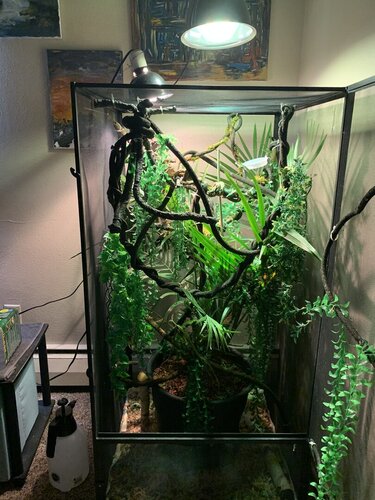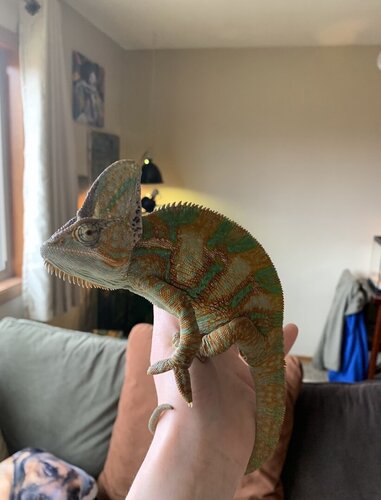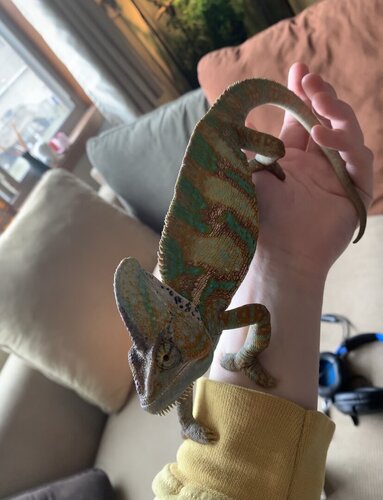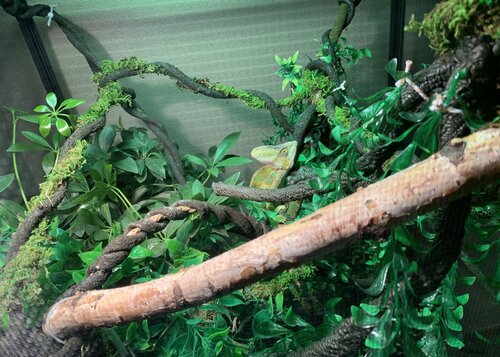mbist
Member
Chameleon Info:
Cage Info:
- Your Chameleon - The species, sex, and age of your chameleon. How long has it been in your care?: I have been caring for a male veiled chameleon. I would guess he was about 3-4 months old when I first got him, and he is approximately a year old now.
- Handling - How often do you handle your chameleon?: Everyday. He is a very friendly chameleon and enjoys coming out of his cage often. When he is out, it's only for about 15 minutes once or twice a day. If it were up to him, he would roam around the house freely.
- Feeding - What are you feeding your cham? What amount? What is the schedule? How are you gut-loading your feeders?: His feeding schedule at this point in time is every other day. He eats a variety of live insects including crickets, dubia roaches, mealworms, black soldier fly larvae, and superworms. Crickets and mealworms are the stables in his diet. On feeding days, I'll give him about 5 crickets and 4 mealworms. Not a huge fan of dubia roaches, but he does go for them time to time. Superworms are a treat, he only gets them about once a week/every other week. The crickets are stored in a plastic bin (with holes for ventilation) and are feed collard greens and provided fluker's orange cubes. He also eats dark greens such as kale, collard, and mustard greens.
- Supplements - What brand and type of calcium and vitamin products are you dusting your feeders with and what is the schedule?: I use Repashy superfoods calcium plus on every feeding.
- Watering - What kind of watering technique do you use? How often and how long to you mist? Do you see your chameleon drinking?: I mist his cage 3-4 times a day for 3-4 minutes as well as using a dripper 1-2 times a day for 15 minutes. Even though the water falls onto his plant and he can clearly see it, he doesn't seem to drink from the dripper. Alas, he does enjoy the water for quick rinse so I still provide. He does drink from the spray bottle I mist him with so I'm not too concerned about his hydration.
- Fecal Description - Briefly note colors and consistency from recent droppings. Has this chameleon ever been tested for parasites?: He has always had normal fecal matter. Mostly solid with a slimy outside, deep brown and mostly white, very slightly yellow urate. He has never been tested.
- History - Any previous information about your cham that might be useful to others when trying to help you: As a baby, he did seem to fall in his cage and fracture his arm. I took him to the vet, but unfortunately because I live in a small town, they were not very experienced with chameleons. It was left to heal on its own. Since then the problem hasn't gotten worse and I changed his tank to be very accessible. He still has a very strong grip and doesn't have problems moving or climbing. In the photos below you can see where the problem. Makes me really sad
but at least it is under control.
Cage Info:
- Cage Type - Zoo Med Reptibreeze screen cage, 2x2x4
- Lighting - What brand, model, and types of lighting are you using? What is your daily lighting schedule?: I use a Zoo Med 100w basking light that is sitting at a 45 degree angle on top of his cage. I also use the Exo Terra Solar Glo 125w uvb light and it is suspended 10-12 inches above his cage. The lights are on about 7am-9pm, the uvb is on 7am-2pm. He does wake up on his own so I just turn his lights on when I notice he has moved from his sleeping spot.
- Temperature - What temp range have you created (cage floor to basking spot)? Lowest overnight temp? How do you measure these temps? His basking spot is at 85ish degrees, which is at the top of the cage. Further down it drops to about 75. I have two thermometers, one at the top and one at the bottom to monitor the different temperatures. The temperature drops to about 70 overnight.
- Humidity - What are your humidity levels? How are you creating and maintaining these levels? What do you use to measure humidity?: 40-50%. Misting his tank a few times a day helps to maintain the humidity, and I am planning on buying a humidifier as well. Our thermometers also have hygrometers on them so we use those.
- Plants - Are you using live plants? If so, what kind?: I use a mix of live and fake plants. I have two plastic plants hanging from the walls and plastic vines hanging from branches. I have a large Ravenea rivularis in the center of his cage.
- Placement - Where is your cage located? Is it near any fans, air vents, or high traffic areas?: At what height is the top of the cage relative to your room floor?: Because of my current limited space, his cage is in the living room. It's placed on the floor, but is not by any fans or vents.
- Location - Where are you geographically located?: Minnesota, USA











